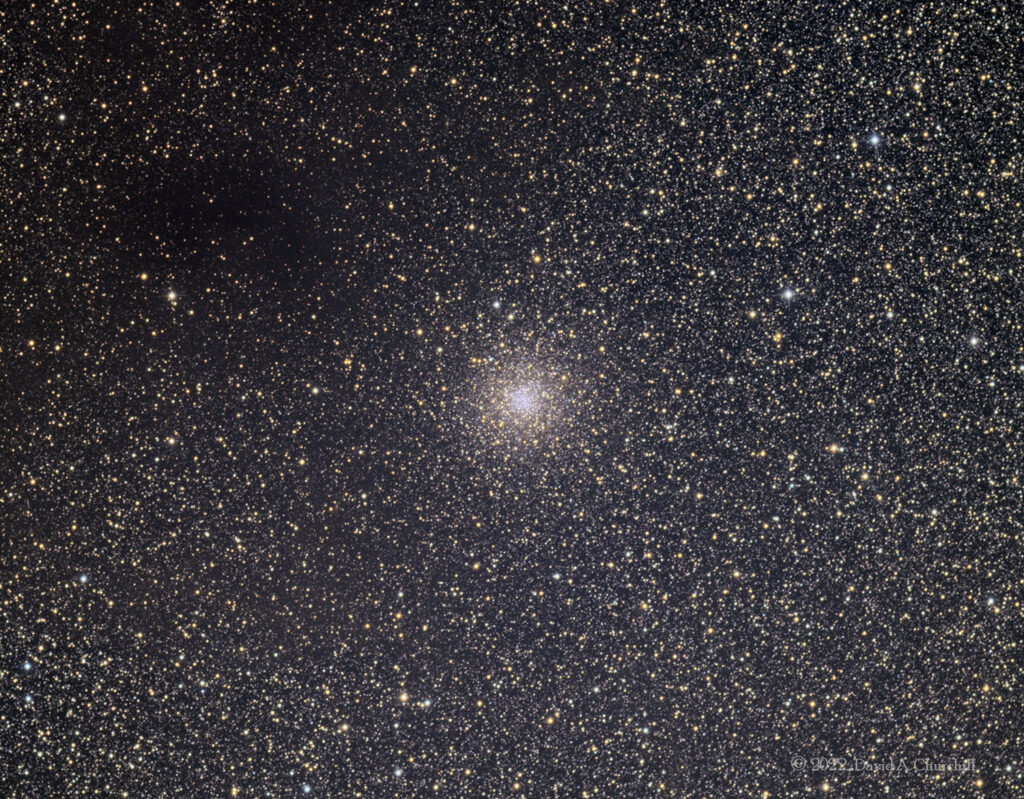Messier 9
Globular Cluster, Ophiuchus
- Description
- Technical
- Links
Messier 9 or M9 (also designated NGC 6333) is a globular cluster in the constellation of Ophiuchus. It is positioned in the southern part of the constellation to the southwest of Eta Ophiuchi, and lies atop a dark cloud of dust designated Barnard 64. The cluster was discovered by French astronomer Charles Messier on June 3, 1764, who described it as a “nebula without stars”. In 1783, English astronomer William Herschel was able to use his reflector to resolve individual stars within the cluster. He estimated the cluster to be 7–8′ in diameter with stars densely packed near the center.
M9 has an apparent magnitude of 7.9, an angular size of 9.3′, and can be viewed with a small telescope. It is one of the nearer globular clusters to the center of the galaxy as is around 5,500 light-years from the Galactic Center. Its distance from Earth is 25,800 light-years. The total luminosity of this cluster is around 120,000 times that of the Sun, the absolute magnitude being -8.04. The brightest individual stars in M9 are of apparent magnitude 13.5, making them visible in moderately sized telescopes. There have been 24 variable stars found in M9: 21 RR Lyrae variables, plus a long-period variable, Type II Cepheid, and an eclipsing binary. No blue stragglers or SX Phoenicis variables have been discovered. Based upon the periods of the RR Lyr variables, this cluster is classified as an Oosterhoff type II globular, which precludes an extra-galactic origin.
M9 has an apparent magnitude of 7.9, an angular size of 9.3′, and can be viewed with a small telescope. It is one of the nearer globular clusters to the center of the galaxy as is around 5,500 light-years from the Galactic Center. Its distance from Earth is 25,800 light-years. The total luminosity of this cluster is around 120,000 times that of the Sun, the absolute magnitude being -8.04. The brightest individual stars in M9 are of apparent magnitude 13.5, making them visible in moderately sized telescopes. There have been 24 variable stars found in M9: 21 RR Lyrae variables, plus a long-period variable, Type II Cepheid, and an eclipsing binary. No blue stragglers or SX Phoenicis variables have been discovered. Based upon the periods of the RR Lyr variables, this cluster is classified as an Oosterhoff type II globular, which precludes an extra-galactic origin.
Telescope: Planewave CDK17 (FR) f4.5
Mount: Astro Physics 1600GTO
Camera: QHY16200A/ Integral FW
Guider: Agena Starguide II / ZWO ASI178MM
Filters: Astronomik 36mm LRGB
L: 32×5 mins = 160 mins, R: 24×5 mins = 120 mins, G: 24×5 mins = 120 mins, B: 24×5 mins = 120 mins
Total Imaging Time: 8h 40m
Data Imaged remotely over 4 nights during August 2022.
Imaged from Observatorio El Sauce, Chile, in partnership with Fred Espenak.
Data acquisition & Processing by David Churchill.
None

